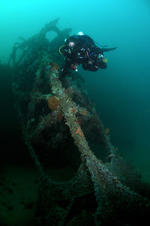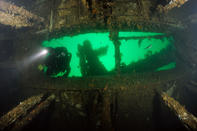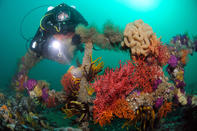Smitswinkel Wrecks

Average depth: 20m / Maximum depth: 37m
The five wrecks in Smitswinkel Bay were purposefully scuttled by the South African Navy in the early 1970’s to form an artificial reef. All the wrecks lie at a depth of over 30m, making them sites for experienced divers. Nitrox training is an obvious bonus and, if qualified, penetration is an option on some of the wrecks.
There are two rigates; the Good Hope and Transvaal, two trawlers; Oratava and Princess Elizabeth, and the diamond dredger, the Rockeater. The SAS Good Hope is identical to the Transvaal except for the fact that she has a helipad at her stern. Several large blast holes in her sides from the explosions that sunk her are also visible. The Good Hope also has a vessel lying off to her side - the fishing trawler Princess Elizabeth. There is extensive coral growth on the Good Hope which supports plentiful aquatic life.
All the wrecks lie at a depth of over 30m, making them sites for experienced divers. Nitrox training is an obvious bonus and, if qualified, penetration is an option on some of the wrecks. There are two rigates; the Good Hope and Transvaal, two trawlers; Oratava and Princess Elizabeth, and the diamond dredger, the Rockeater.
The SAS Good Hope is identical to the Transvaal except for the fact that she has a helipad at her stern. Several large blast holes in her sides from the explosions that sunk her are also visible. The Good Hope also has a vessel lying off to her side - the fishing trawler Princess Elizabeth. There is extensive coral growth on the Good Hope which supports plentiful aquatic life.
MV Rockeater

The MV Rockeater was used for diamond prospecting and offshore drilling in Namibia. She was scuttled in the early 1970s to form an artificial reef. This is a challenging dive for the more experienced diver due to its depth and the fact that it lies more than 200m from the other wrecks.
One of the best parts of the wreck is entering the deck below the main deck and looking up at the shafts of light penetrating the many holes in the upper deck. The MFV Oratava was formerly an I&J fishing trawler which was scuttled in the 1970s. The Oratava lies off the stern of the SAS Transvaal - she is somewhat disorienting to swim through as she lies slightly on her side. The wreck is still very much intact and has some very exciting swim-throughs for divers to explore.
MFV Princess Elizabeth

Lying close to the Good Hope in Smitswinkel Bay, the was scuttled in July 1983. She was a fishing vessel built in England and sold to I&J in 1969. The Princess Elizabeth is a wooden ship which makes for a really nice dive, especially for those interested in wreck penetration. On all these wrecks you can encounter photogenic lobsters hidden in convenient holes in the masts, a variety of Nudibranchs curled up amongst the soft carpets of corals and a host of sponges.
These wrecks, covered with mauve, red and white soft corals, Sea fans and anemones, are really a feast for the eye when a light source is applied. Starfish are common in the area and the superstructures are heavily encrusted with Hydroids, sea cucumbers, Sea squirts and Tube worms. Resident fish in this area include Galjoen, Catsharks, Hottentots, Janbruins, Romans and Strepies.
By Johan Boshoff False Bay is so named because many sailors returning from the East used to mistake Cape Hangklip (near Hermanus) for Cape Point. As a result...
False Bay is so named because many sailors returning from the East used to mistake Cape Hangklip (near Hermanus) for Cape Point. As a result... Self drive routes from Cape Town invite visitors to the Mother City to experience the natural splendour, fun activities and scenic attractio...
Self drive routes from Cape Town invite visitors to the Mother City to experience the natural splendour, fun activities and scenic attractio...